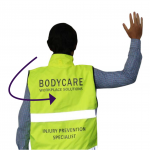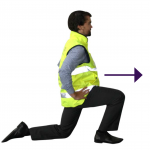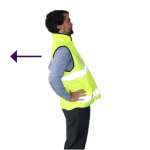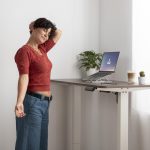Is Your at Home Workstation Set Up Affecting Your Posture?

Ergonomics – the design and arrangement of equipment to maximise safety while in use is an important part of employee health and safety. Poor ergonomic practices such as incorrect workstation set ups, prolonged sitting or unfavourable positions can lead to musculoskeletal complaints, particularly of the neck, shoulders and back.
With the typical workspace landscape evolving and more and more organisations shifting to remote work or a hybrid working model, the prevalence of these injuries may be increased. Due to a lack of proper ergonomic set up, the home environment can lead to poor postures and an increased chance of injury. Fortunately, there are practices we can implement to protect ourselves and our team members.
To help share these insights with you, David Carroll (General Manager of Bodycare NZ) has put pen to paper to share everything you need to know about posture and at home workstation set up.
Q1. What is posture and why is it important?
Posture is defined as the position in which you hold your body upright against gravity while standing still or lying down. It derives from the Latin word ‘ponere’, which means to ‘put’ or ‘place’. Different postures are important for different activities, e.g. dancing, riding a horse and many others. In these activities, correct body positioning has been shown to be advantageous from a performance context.
Q2. For 18 months, millions of employees have been working from home, in many cases without a proper ergonomic set-up. What effect has this had on our posture?
There is no evidence available that shows a link between sitting posture at a desk, pain and general health. If you don’t have any pain you’re better off focusing on exercising regularly, getting good quality sleep and reducing your daily stress. If you had an episode of back pain then yes, posture may affect it – in this incidence, you’re better off avoiding prolonged sitting and consulting a health professional such as a Physiotherapist.
An anecdotal impact of working from home (WFH) is that we are more sedentary and working longer hours. We are missing the incidental exercise of walking to work / the car, walking to the meeting room etc. It is also harder to separate home and work life which can lead to longer work days and less time for ourselves and our families. WFH can also impact our sense of connection because we are seeing fewer people. All of these factors can impact our mental and physical health and wellbeing.
Q3. How do we know if we have a “good” or “bad” posture?
Unfortunately, this isn’t a black and white answer, as different postures suit different people. For example, 295 Physiotherapists from four European countries were asked to pick a perfect posture from nine picture options ranging from slumped to upright. 85% of the Physiotherapists chose one of two postures, however, these were very different, one having less lumbar curve and the other having a more erect upper back. The researchers found that these postures would need higher levels of muscle activity which could result in greater tiredness and discomfort. The study concluded that disagreements remain on what is a good (or bad) sitting posture 1.
In saying that, some common postures that are considered problematic are forward head postures and rounded shoulders which can be caused by sitting for prolonged periods or sitting without support (i.e. on the couch or in bed).
It’s also important to note that posture can become a problem when it is sustained over a long period of time. To combat this, it’s important to modify your posture regularly and introduce stretching and movement breaks throughout the day. Tips include: taking your phone calls standing up, introducing walking phone meetings, standing and stretching (with a TheraBand) for 2 minutes, every 30 minutes etc.
Q4. What are the long-term effects of bad posture?
I don’t like the term ‘bad posture’ as any posture will cause discomfort if it is held for a prolonged period. Given that there have been no studies that link ‘bad posture’ to any general health problems, the key is to modify your posture regularly especially as prolonged or sustained postures can lead to muscle soreness and stiffness and headaches.
Q5. Please provide your top tips for the best ergonomic set-up for posture (i.e. ergonomic chair, correct sitting position, desk height, the height of monitor, etc)?
- Use an adjustable supportive chair with a high back rest and lumbar support. The backrest ideally should be slightly reclined to 10–20 degrees from a vertical upright position and the chair should support the entire spine.
- Elevate your screen to eye height by placing your laptop on a box and using a wireless keyboard or mouse or alternatively a second screen. Ensure your screen is approximately an arm’s length from you.
- Adjust your chair or sit at a table such that your elbows are just above the height of the desk.
- Most importantly – change postures every 30-45 minutes
Q6. If we’ve compromised our posture through unhealthy work from home/work from anywhere habits and/or an equipment/home office set-up that’s not ergonomic, what can we do to reverse the damage?
You probably haven’t compromised your posture, instead, you have changed how you would normally sit. This isn’t necessarily a bad thing.
However, if you want to make a change, now that you don’t have a long commute to the office, increasing your daily exercise is the key to living a prolonged life! The World Health Organisation recommends that healthy adults should complete at least 150-300 minutes of moderate intensity aerobic physical activity or at least 75-150 minutes of vigorous intensity activity throughout the week. It’s also important to do muscle strengthening activities that involve all major muscle groups on two or more days a week. To help reduce the detrimental effects of high levels of sedentary behaviour on health (eg. long periods of sitting at your desk) all adults should aim to do more than the recommended level of moderate to vigorous intensity physical activity.
Other tips include:
- Use a supportive chair.
- Elevate your laptop to eye height and use a wireless keyboard and mouse (or use a second screen).
- Alternate between sitting and standing postures.
Q7. When should you see an expert to help correct your posture (i.e. physiotherapist)?
If you’ve no pain with your posture you don’t need to worry about it. If you are experiencing pain, then you should consult a physiotherapist who can assess you and your history and provide a comprehensive plan to help you reduce your pain.
Q8. What are the benefits of an ergonomic assessment of your workstation?
Ergonomic assessments help educate you so that you can optimise your health at work and avoid pain and discomfort. An ergonomic assessment will ensure you have the most optimal set-up for you and will provide tips on what you can do to look after yourself, i.e., move regularly and change postures frequently. They also assess your environment (e.g lighting, glare, noise, etc.) and the impact it may have on your health.
Q9. How long can it take to correct “bad” posture?
Any posture will cause discomfort if you sustain it for long periods of time. Therefore, it is difficult to correct ‘bad’ posture as every posture would become ‘bad’ at some point. Unless you have pain, you don’t need to correct ‘posture’. Focusing on trying to vary your posture throughout the day is more important.
Q10. What can we do to prevent slouching and improve our posture as we WFH today and into the future?
Use a supportive chair (get off the couch or out of bed) and remember to vary your position throughout the day, get some exercise and reduce your stress.
Q11. What are some exercises you can do at your desk and at home to improve your posture daily?
Try and move more. Vary your posture throughout your day. I recommend standing or going for a walk around the house while taking phone calls. Try not to spend your breaks, sitting at your desk. You could try replacing your daily commute to/from the office with some exercise; bring the dog for a walk or go for a run when you would normally be sitting in traffic.
There is also the rule of ‘curve reversal’ which you can keep in mind. For example, if you’ve been leaning over your desk, stretch back the other way. You can also perform stretching exercises daily to boost muscle flexibility and exercise regularly to improve muscle strength and tone.
Here are a few simple exercises that can be performed to counteract postural stiffness due to prolonged sedentary behaviour:
- Stand up straight with your hand behind your back.
- Tilt your ear to your shoulder using your hand to gently apply pressure on your head to increase the stretch.
- Hold for 30 seconds.
- Repeat 3 times for each side.
- Stand up straight and tuck your chin into your chest to create a double chin.
- Use one hand to apply pressure to your chin to increase the stretch.
- Hold for 30 seconds.
- Repeat 3 times.
- Place your forearm against a door frame, ensuring your elbow is bent at 90º.
- Gently rotate your body the opposite way as far as comfortable.
- Hold for 30 seconds.
- Repeat 3 times for each side.
- Kneel down on your knee with your opposite hip and knee bent at 90º.
- Gently push your pelvis forwards without arching your lower back.
- Hold for 30 seconds.
- Repeat 3 times for each side.
- Lie on your side with knees bent to 90º and hands on top of each other.
- Rotate your upper body without moving your knees.
- Repeat 5 times for each side.
Here are 5 tips to help you look after yourself while you work from home:
Sit at a table and choose a chair that provides good postural support – avoid sitting on the couch, bed or floor.
Stand at your kitchen bench where possible and alternate between sitting and standing every 20-30 minutes.
Frequent breaks and regular stretches of the neck, shoulders and back are vital. Try walking around the block or standing in your garden or on your balcony when you’re on a call. Use your normal commute time to exercise.
Use a separate monitor if available. If you only have a laptop, use a separate mouse and keyboard and place your laptop on a ream of paper or a book so that the top of the screen is at eye level.
If you or your team would like advice on your at home or in office ergonomic set-ups, one of our Injury Prevention Specialists can help. Reach out to our team today for more information.
References:
- O’Sullivan, K., O’Sullivan, P., O’Sullivan, L., Dankaerts, W. (2012). What does physiotherapists consider to be the best sitting spinal posture. Manual Therapy, 17 (5), 432-7.








